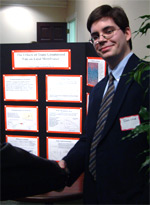
Typical Class Profile
Over the past 10 years, we have graduated an average of 12 majors per year. Of these, 42% have gone directly to graduate school in either chemistry or biochemistry and 28% have gone directly to medical school.
The remaining 30% have gone to other professional schools (law, business and physiology, for example) or have found employment in chemical industry, high school teaching, business or the computer field.
For a quick look at the post-graduate placement of chemistry majors in some recent graduating classes, click here.
 Jon O’Donnell was the commencement speaker for the Wabash Class of 2010. He did cancer research internships over the summer, studied abroad, minored in philosophy, and scored a perfect 40 on his Medical College Admission Test.
Jon O’Donnell was the commencement speaker for the Wabash Class of 2010. He did cancer research internships over the summer, studied abroad, minored in philosophy, and scored a perfect 40 on his Medical College Admission Test.
His mother's battle with cancer inspired him to pursue oncology as a specialty, and he's begun work on his medical degree at the Duke University School of Medicine. Read more about Jon.
Many of our chemistry majors participate in on- and off-campus research internships. The Wabash chemistry department faculty employ about a dozen students each summer. You can read about their experiences below.
 A unique research project put two Wabash chemistry majors out of their comfort zones. Shane Evans ’12 and Seth Bawel ’12 spent an eight-week internship under Chemistry Professor Ann Taylor. The duo worked primarily with a number of plants,l researching how different types of bacteria will affect the organisms and how other variables such as herbs and spices interact with plants.
A unique research project put two Wabash chemistry majors out of their comfort zones. Shane Evans ’12 and Seth Bawel ’12 spent an eight-week internship under Chemistry Professor Ann Taylor. The duo worked primarily with a number of plants,l researching how different types of bacteria will affect the organisms and how other variables such as herbs and spices interact with plants.
For the Wabash juniors, the internship required more biology knowledge than either possessed. Both agreed the hands-on experience allowed them to pick up quickly the biology terminology to be successful in their research. Read more about their internship.
 Wabash Chemistry Professor Walter Novak and students Austin Drake ’11 and Matt Schenkel ’12 might be the first people called if the United States suffers a bioterrorism attack. The three spent the first half of the summer searching for a protein inhibitor that could stop the organism “Francisellatularensis” from being used as a bioweapon. The organism was made into a weapon during World War II and all stock piles were believed to have been destroyed after the war.
Wabash Chemistry Professor Walter Novak and students Austin Drake ’11 and Matt Schenkel ’12 might be the first people called if the United States suffers a bioterrorism attack. The three spent the first half of the summer searching for a protein inhibitor that could stop the organism “Francisellatularensis” from being used as a bioweapon. The organism was made into a weapon during World War II and all stock piles were believed to have been destroyed after the war.
 One pre-med Wabash chemistry major, Jake Ezell ’11, has kept a blog during the entire time he's been at Wabash. And Jake has had a remarkable career at the College, too.
One pre-med Wabash chemistry major, Jake Ezell ’11, has kept a blog during the entire time he's been at Wabash. And Jake has had a remarkable career at the College, too.
 For Austin Drake ’11, a summer research internship with Professor Wally Novak changed not only the way he sees science; it also changed the relationship he has with his professor. Drake thought he was headed to Haiti on a mission trip in the summer of 2010. Instead, the Farmersburg, Indiana native worked side by side with Professor Novak in original research in bioterrorism.
For Austin Drake ’11, a summer research internship with Professor Wally Novak changed not only the way he sees science; it also changed the relationship he has with his professor. Drake thought he was headed to Haiti on a mission trip in the summer of 2010. Instead, the Farmersburg, Indiana native worked side by side with Professor Novak in original research in bioterrorism.
"He's teaching me and mentoring me," said Drake, "but at the same time we're both discovering things at the same time." See a video with Austin Drake.
 Professor Scott Feller received a National Science Foundation grant of approximately $500,000 to further his continuing research on cell membrane permeability. Professor Feller researches the interactions between the molecules that comprise cell membranes to benefit pharmaceutical companies, nutritionists, and even a baby formula manufacturer.
Professor Scott Feller received a National Science Foundation grant of approximately $500,000 to further his continuing research on cell membrane permeability. Professor Feller researches the interactions between the molecules that comprise cell membranes to benefit pharmaceutical companies, nutritionists, and even a baby formula manufacturer.
Not only does the grant extend to 17 years the length of Professor Feller's research, it has worked out to be a gold mine... for his students, too. Xingcheng Liu ’10 recently presented research at the American Chemical Society's national meeting in San Francisco, while current intern Mike Lu is working side-by-side with his professor. Read more about Dr. Scott Feller's NSF grant.
